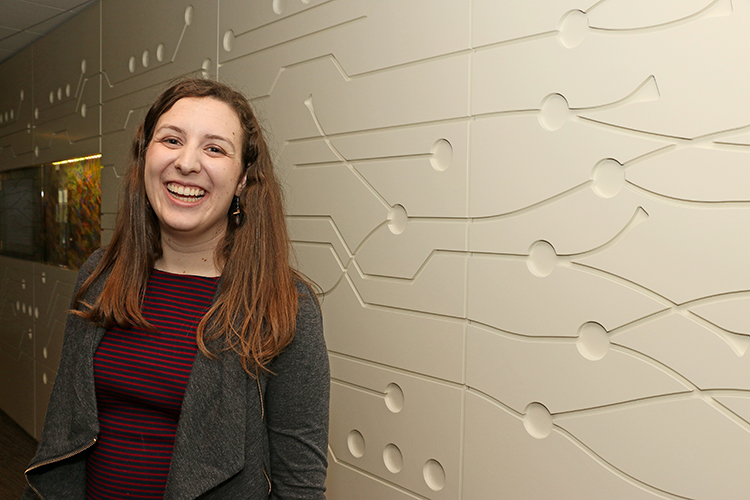 In addition to conducting her own research on brain-computer interfaces, Kaitlyn Casimo is helping to make neural engineering easier to understand for high school students and the general public.
In addition to conducting her own research on brain-computer interfaces, Kaitlyn Casimo is helping to make neural engineering easier to understand for high school students and the general public.
To say that Kaitlyn Casimo has a passion for science would be an understatement, as evidenced by both her educational focus and volunteer activities. Casimo holds an undergraduate degree in neuroscience from Pomona College, where she also minored in theater and psychology. She is currently a fifth-year doctoral student in the University of Washington (UW) Graduate Program in Neuroscience.
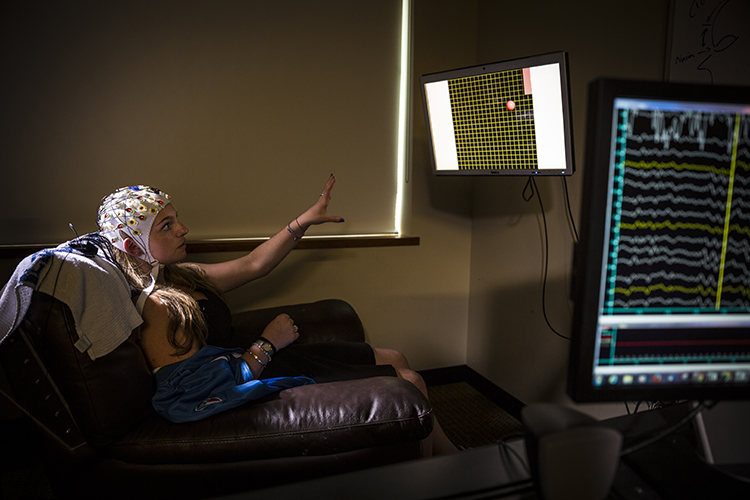 At the UW, she is conducting her own research on topics such as how learning to use a brain-computer interface affects connectivity in the whole brain, while explaining science to the public at the Woodland Park Zoo, Neuroscience Community Outreach, the Pacific Science Center and the Center for Sensorimotor Neural Engineering (CSNE). If there is a unifying thread that ties together all her varied roles at these institutions, it could be Casimo’s exceptional ability to make complex subject matter easy to comprehend.
At the UW, she is conducting her own research on topics such as how learning to use a brain-computer interface affects connectivity in the whole brain, while explaining science to the public at the Woodland Park Zoo, Neuroscience Community Outreach, the Pacific Science Center and the Center for Sensorimotor Neural Engineering (CSNE). If there is a unifying thread that ties together all her varied roles at these institutions, it could be Casimo’s exceptional ability to make complex subject matter easy to comprehend.
“Science shouldn’t be opaque. The goal isn’t to mystify,” Casimo said. “The goal is the opposite. It’s to make things clearer and more understandable.”
Helping university students explain neural engineering to the public
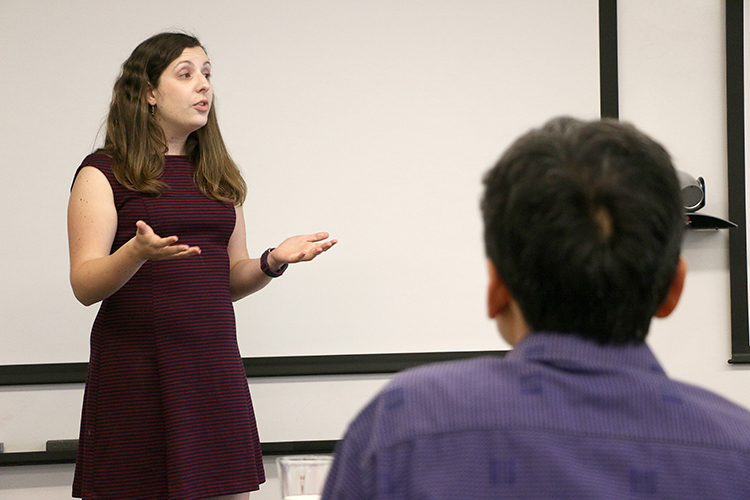 In her role as the CSNE’s Student Leadership Council Outreach and Communication Coordinator, which is new for the Center, Casimo is building-up a strong core of student volunteers who will have the confidence and necessary skills to do public outreach on behalf of the CSNE. She is helping these CSNE-affiliated students learn how to clearly explain their research and construct educational outreach resources in workshops she is leading during the 2017–18 academic year. Casimo intends to create a robust volunteer and activity base that hasn’t existed before at the Center, paving the way for the next CSNE student member in her position.
In her role as the CSNE’s Student Leadership Council Outreach and Communication Coordinator, which is new for the Center, Casimo is building-up a strong core of student volunteers who will have the confidence and necessary skills to do public outreach on behalf of the CSNE. She is helping these CSNE-affiliated students learn how to clearly explain their research and construct educational outreach resources in workshops she is leading during the 2017–18 academic year. Casimo intends to create a robust volunteer and activity base that hasn’t existed before at the Center, paving the way for the next CSNE student member in her position.
“In the fall, I’m running a series of workshops on effective communication skills for talking with the public, which is not totally separate from effective communication skills for talking to other scientists, but it is a distinct style and requires a distinct skillset,” Casimo said. “In the winter quarter, I’m going to have a four-month sequence where people will get to build a self-contained, interactive activity that demonstrates a concept of neural engineering, something like, ‘How does an orthotic get fit to a patient?’ or ‘What does spinal stimulation do?’ or ‘What does it take to decode neural signals recorded from the motor cortex?’”
Participants in Casimo’s workshops will learn how to build fundamental communication skills, communicate complex ideas to different audiences, assess their audience’s needs and simplify their research to only essential language. The hands-on activities they develop, demonstrating neural engineering concepts, will be used in future CSNE outreach events to students and to the public. In leading these workshops, Casimo has drawn from her own past teaching experiences.
Teaching neural engineering to high school students
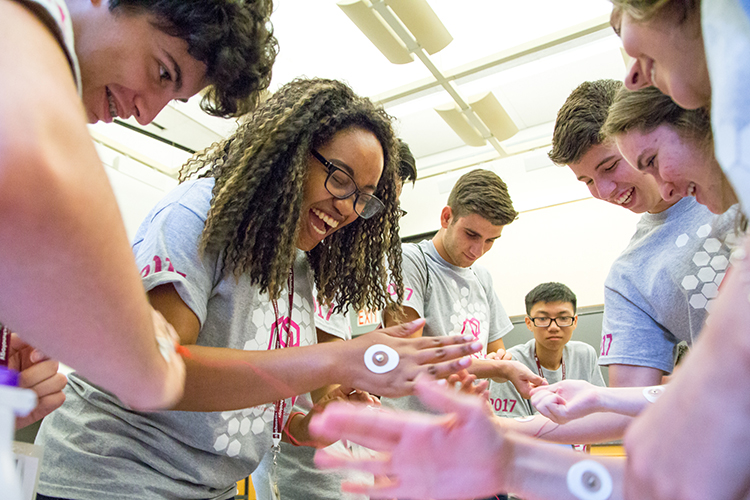 For the past two summers, Casimo has taught a six-week neural engineering course to high school students as part of the UW Math Science Upward Bound program (STEMsub). Last summer, she also taught two workshops at the Massachusetts Institute of Technology (MIT) for high school students who were part of the MIT Online Science, Technology and Engineering Community (MOSTEC) program. Both programs are aimed at serving low-income, traditionally underrepresented students who potentially are the first members of their families to attend college. Casimo noted that while bringing neural engineering into plain, easy-to-understand terms for high school students may be challenging, explaining its real-world impact is not.
For the past two summers, Casimo has taught a six-week neural engineering course to high school students as part of the UW Math Science Upward Bound program (STEMsub). Last summer, she also taught two workshops at the Massachusetts Institute of Technology (MIT) for high school students who were part of the MIT Online Science, Technology and Engineering Community (MOSTEC) program. Both programs are aimed at serving low-income, traditionally underrepresented students who potentially are the first members of their families to attend college. Casimo noted that while bringing neural engineering into plain, easy-to-understand terms for high school students may be challenging, explaining its real-world impact is not.
“Something like one in three people will experience a neurological condition at some point in their life,” Casimo said. “My students always know somebody who has something, like a grandparent with Parkinson’s disease or a cousin with epilepsy or a neighbor with an amputation, that sort of thing. Everybody knows someone—everybody. This isn’t abstract to them.”
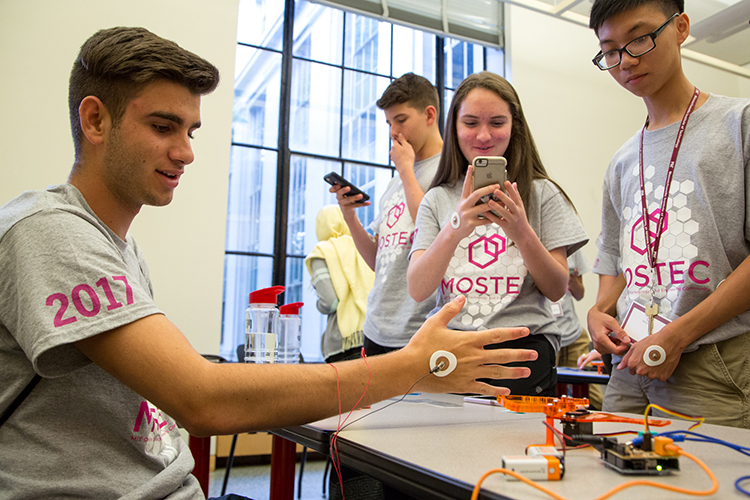 Casimo kept the overall atmosphere of the UW STEMsub classes and MOSTEC workshops open to conversation and questions. Students appreciated this open environment and that Casimo gave positive feedback while taking the time to make sure they understood the subject matter.
Casimo kept the overall atmosphere of the UW STEMsub classes and MOSTEC workshops open to conversation and questions. Students appreciated this open environment and that Casimo gave positive feedback while taking the time to make sure they understood the subject matter.
“She just explained the material so well that really anyone who didn’t know anything about neuroscience would understand it,” said Michelle Ly, one of Casimo’s STEMsub students and a CSNE Young Scholars Program participant. “Not many people can do that. Once you are at such a high level of expertise it’s difficult to go back and explain it to someone that knows nothing. If you can do that it just shows how good you are at teaching.”
Casimo took what she learned developing lesson plans and activities for these high school level classes and workshops and used that knowledge to create a self-paced online course, Introduction to Neural Engineering, which is being shared with other educators through the CSNE website.
Future Plans
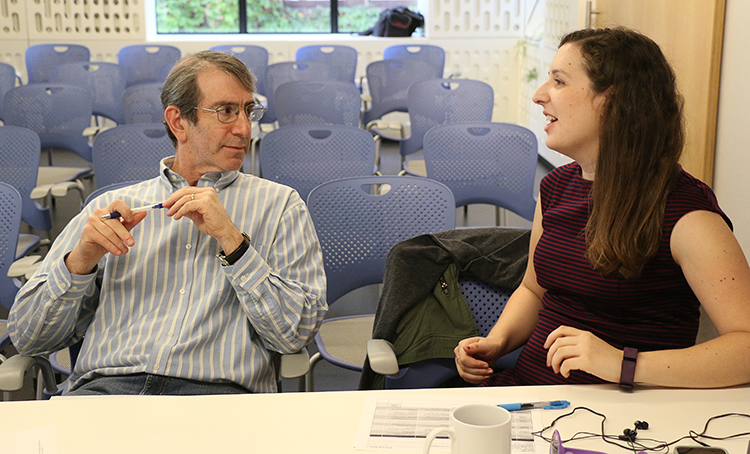 Casimo plans to graduate in May 2018, so she is currently looking into jobs that help people understand science better and/or make better decisions using science and scientific thinking.
Casimo plans to graduate in May 2018, so she is currently looking into jobs that help people understand science better and/or make better decisions using science and scientific thinking.
“I would like to see governments and corporations and universities incorporating science, both in terms of data and scientific thinking, into their decision-making more centrally. The jobs that I’m considering would put me in a position where I could help organizations make better decisions,” Casimo said. “In a more intangible way, I would like to help everybody, not just organizations, not just the people who have the power to make decisions and change things, but everybody see science as a public resource. Science and data are for everybody. Maybe it seems a little scary to some to not understand all of the technical details, but what scientists do and what we find is for everyone.”
For more information about Kaitlyn Casimo's work with the CSNE and other organizations, send her an email or visit her website.
